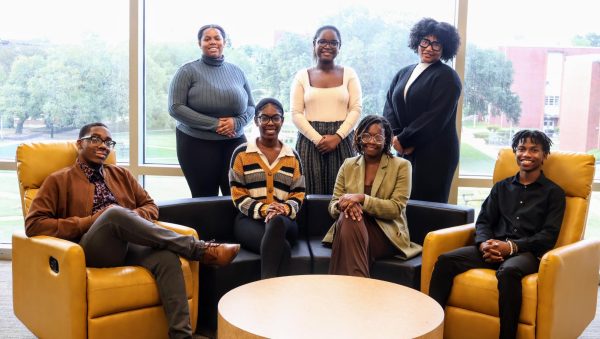Column: Why is there so much sexual violence on college campuses?
![Stop Sexual Assault. (2021). [Photo]. https://www.dvifallon.org/resources/what-is-sexual-violence/](https://asuhornettribune.com/wp-content/uploads/2021/09/img-sexual-violence.jpg)
Stop Sexual Assault. (2021). [Photo]. https://www.dvifallon.org/resources/what-is-sexual-violence/
September 11, 2021
According to the Rape, Abuse, & Incest National Network (RAINN), 13% of students experience rape, or any other type of sexual assault through force, throughout their collegiate years. Plaguing all gender types, an average of 26.4% of undergraduate women, 6.8% of undergraduate men, and 21% of the transgender, nonbinary, and queer student population have been found victims of these violent acts.
As if these statistics were not alarming enough, it is also believed that approximately 90% of sexual assault cases occurring on college campuses go unreported. These numbers should be disturbing to all, as it seems that no person is completely safe from the threat of sexual violence on a college campus. While it is vital we put forth efforts to lower these rates, we must first discuss the root of the problem. Why is sexual assault so common on college campuses?
Thankfully, we are far out of the age of victim-blaming. Now accepting that a victim’s appearance, intoxication levels, nor anything else warrant rape, we know the only thing that causes such violence is the rapist. According to studies done at Harvard University, four well-supported theories explain the motivations of rape.
There is the biological theory arguing that some are driven to rape to increase their chances of reproducing. The developmental theory conveys that rapists typically come from developmentally harsh environments where manipulation and abuse are normalized. The control theory believes rapists are motivated by their hunger for power and dominance rather than sexual desire. Finally, the commodity theory, explains that rapists see sex as a commodity, or an item, that can easily be taken rather than an intimate action shared between two consenting individuals.
While all of the provided theories are backed by impressive amounts of evidence, the commodity theory most prominently stands out to me as a student on a college campus. We live in a society where the talk of sex is high, yet its appreciation is low. It seems that in efforts to normalize aspects of sex that would otherwise have a negative stigma, such as queerdom, STI’s, sexual work, etc., society has inadvertently caused sex to be seen as no big deal. Though I believe there are productive qualities to this normalization, it comes with desensitization to the intimate nature of sex.
Considering sex is now accepted to be no big deal, it has become a significant force in the media that this generation of college students consume. We live in an era where commercials with women in bikinis riding motorcycles are used for advertising cheeseburgers. The game “Smash or Pass” is commonly played by college-aged influencers and broadcast over social media. Literally, the hit line of the song ‘On Me’ by rapper Lil Baby, one commonly streamed by students on this college campus specifically, says, “Come and put that p**** on me, don’t be running from it.” With the talk of sex and genitalia being so common, one can see where it causes the actual sexual action to be devalued.
In her journal “What Makes a Rapist?” Katharine Baker of Harvard Law says, “…youths, particularly young men, are bombarded by a culture that sexualizes commodities and commodifies women’s sexuality. Companies sell products by selling the sexuality of the women endorsing the product. The product and the sex are purposefully conflated.”
This cultural endorsement and marketing of sex as a commodified good, leads to an increased desire for, and sense of entitlement to, sex. Most men are taught that sexual desire is like hunger: when it is there, you satisfy it. Women are candy bars. Of course, food is not free, and neither is sex, but precisely because men can and do pay for sex, taking it without consent becomes much less morally reprehensible than other violent crimes. Men know that taking sex without consent is wrong, but many men do not perceive it as really bad.
This phenomenon led to assaulters not feeling guilt or shame toward their actions but to them not realizing when their actions are offensive. How can they know what they are doing is wrong when their favorite song or YouTuber says otherwise?
To remedy this ongoing battle regarding sexual violence in an organized setting, the Center for Disease Control and Prevention (CDC) has a simple solution, education for prevention and security for protection. They encourage us to begin including the topics of consent, healthy relationship models, and respect in our conversations about normalizing sex. While they might not be the most ‘exciting’ aspects of sex, they are surely the most important. The CDC also calls for increased security among campuses everywhere.
In their section titled “Sexual Violence is Preventable,” the CDC includes, “Improve safety monitoring in schools by addressing areas where students feel less safe, identifying safe spaces and staff support for students, and create an atmosphere of intolerance for harassment and violence.”
As a college student, one is paying to live on a college campus for a college education. There is no reason someone should feel at risk of sexual violence in the midst of that. Sexual violence is most common on college campuses than anywhere else, and that should not be so. At some point, this vicious cycle should end.
















